
|
Now it is bright as 8.7 mag (July 13, Chris Wyatt). It stays bright as 8-9 mag for a while. In the Southern Hemisphere, it stays observable in good condition for a long time until the comet will fade out. In the Northern Hemisphere, it is not observable for a long time until autumn in 2019 when the comet fades out down to 16 mag.
Date(TT) R.A. (2000) Decl. Delta r Elong. m1 Best Time(A, h)
July 14 16 37.27 -52 38.2 1.398 2.233 134 8.5 21:07 ( 0, 2)
July 21 16 5.73 -54 33.6 1.482 2.223 124 8.6 20:52 ( 6, 0)
|
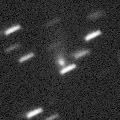
|
Now it is very bright as 9.4 mag (July 13, Chris Wyatt). In the Southern Hemisphere, it is observable from July to September, but it locates in extremely low. In the Northern Hemisphere, it is not observable until late December.
Date(TT) R.A. (2000) Decl. Delta r Elong. m1 Best Time(A, h)
July 14 6 15.32 -4 43.1 1.485 0.831 32 9.1 3:13 (260,-22)
July 21 6 53.17 -10 51.2 1.406 0.826 35 8.9 3:19 (265,-26)
|
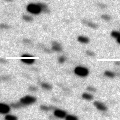
|
It brightened rapidly. Now it is very bright as 8.4 mag (July 15, Edwin van Dijk). It is expected to approach to Sun down to 0.2 a.u. and brighten up to 3 mag in August. In the Northern Hemisphere, it stays observable in the morning sky until early August when the comet brightens up to 6 mag. It is not observable at all in the Southern Hemisphere.
Date(TT) R.A. (2000) Decl. Delta r Elong. m1 Best Time(A, h)
July 14 4 20.06 57 39.9 1.230 0.965 49 10.3 3:13 (219, 32)
July 21 5 14.84 54 18.1 1.051 0.807 45 9.2 3:19 (221, 28)
|
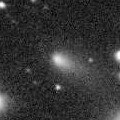
|
Now it is very bright as 10.0 mag (July 13, Maik Meyer). It will brighten rapidly, and brighten up to 7 mag from August to September. In the Northern Hemisphere, it will be observable in excellent condition. In the Southern Hemisphere, it will be unobservable from July to August. But it will be observable in good condition before and after that.
Date(TT) R.A. (2000) Decl. Delta r Elong. m1 Best Time(A, h)
July 14 22 10.60 57 27.0 0.737 1.298 94 10.1 2:43 (180, 68)
July 21 22 43.24 61 4.8 0.679 1.242 92 9.6 2:48 (180, 64)
|

|
Bright new comet. Now it is 10.7 mag (July 15, Chris Wyatt). It approaches to Earth down to 0.3 a.u. in late July, and it will move very fast in the southern sky. It stays observable in good condition until September. It locates somewhat low in the Northern Hemisphere.
Date(TT) R.A. (2000) Decl. Delta r Elong. m1 Best Time(A, h)
July 14 0 27.57 -17 1.0 0.582 1.339 110 11.1 3:13 (328, 32)
July 21 23 10.07 -27 20.1 0.383 1.320 136 10.1 3:19 ( 0, 28)
|
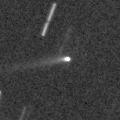
|
It brightened rapidly as predicted. Now it is very bright as 11.1 mag (July 13, Chris Wyatt). In the Southern Hemisphere, it stays observable in good condition all through this apparition. In the Northern Hemisphere, it is not observable at the high light from mid June to mid August.
Date(TT) R.A. (2000) Decl. Delta r Elong. m1 Best Time(A, h)
July 14 7 1.31 -21 10.9 0.239 0.859 43 10.9 3:13 (268,-41)
July 21 6 4.74 -28 10.0 0.236 0.906 56 11.4 3:19 (287,-26)
|

|
Now it is 11.3 mag (July 9, Juan Jose Gonzalez). It stays bright as 11 mag for a long time until autumn. In the Southern Hemisphere, it is not observable for a long time after this. In the Northern Hemispehre, it stays observable for a long time until the comet fades out. But it stays very low until autumn.
Date(TT) R.A. (2000) Decl. Delta r Elong. m1 Best Time(A, h)
July 14 8 23.89 52 31.9 3.496 2.693 32 11.4 20:57 (147, 12)
July 21 8 45.96 52 41.4 3.504 2.713 33 11.4 20:52 (148, 12)
|
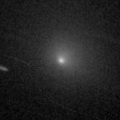
|
It brightened rapidly, and brightened up to 10.2 mag from May to June (May 22, Chris Wyatt). Now it is fading. But it is still bright as 12.3 mag (July 11, Chris Wyatt).In the Southern Hemisphere, it stays observable in excellent condition. It will be getting higher gradually after this also in the Northern Hemisphere.
Date(TT) R.A. (2000) Decl. Delta r Elong. m1 Best Time(A, h)
July 14 1 19.37 -19 29.3 0.924 1.486 99 12.0 3:13 (318, 24)
July 21 1 24.22 -18 15.6 0.922 1.533 104 12.4 3:19 (324, 28)
|

|
Now it is 11.7 mag (June 12, Juan Jose Gonzalez). It stays 12 mag for a long time until spring in 2019. In the Northern Hemisphere, it stays observable in good condition for a long time, although it becomes unobservable temporarily from mid June to August. In the Southern Hemisphere, it is not observable until September.
Date(TT) R.A. (2000) Decl. Delta r Elong. m1 Best Time(A, h)
July 14 8 24.07 32 41.8 3.633 2.669 15 12.3 20:57 (133, -2)
July 21 8 28.64 30 47.4 3.655 2.669 12 12.3 20:52 (135, -6)
|

|
Now it is bright as 13.0 mag (July 13, Chris Wyatt). It stays at 12-13 mag from summer to autumn. It is observable in excellent condition in the Southern Hemisphere. It locates somewhat low in the Northern Hemisphere.
Date(TT) R.A. (2000) Decl. Delta r Elong. m1 Best Time(A, h)
July 14 22 38.30 -18 5.3 1.157 2.018 136 13.0 3:12 ( 0, 37)
July 21 22 41.46 -19 14.5 1.111 2.012 142 12.9 2:48 ( 0, 36)
|

|
Now it is 14.2 mag (July 13, Toshihiko Ikemura, Hirohisa Sato).
Date(TT) R.A. (2000) Decl. Delta r Elong. m1 Best Time(A, h)
July 14 23 20.31 1 27.6 5.206 5.777 119 13.3 3:13 (342, 55)
July 21 23 19.42 1 33.3 5.115 5.777 126 13.3 3:19 (357, 57)
|
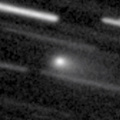
|
Now it is bright as 12.9 mag (July 13, Chris Wyatt). It will be observable at 12-13 mag in good condition from spring to summer.
Date(TT) R.A. (2000) Decl. Delta r Elong. m1 Best Time(A, h)
July 14 23 41.57 0 46.7 1.060 1.753 115 13.4 3:13 (333, 53)
July 21 23 44.32 2 11.4 1.033 1.780 120 13.5 3:19 (346, 56)
|

|
Now it is 12.8 mag (July 13, Seiichi Yoshida). It will be observable at 12-13 mag for a long time from 2017 to 2018. In the Southern Hemisphere, it will be hardly observable after this.
Date(TT) R.A. (2000) Decl. Delta r Elong. m1 Best Time(A, h)
July 14 11 46.47 45 20.6 4.416 3.945 56 13.8 20:57 (124, 37)
July 21 11 44.76 44 2.8 4.513 3.965 51 13.9 20:52 (124, 33)
|
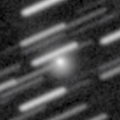
|
Now it is 13.6 mag (July 13, Seiichi Yoshida). It stays 13-14 mag until summer in 2019. In the Northern Hemisphere, it stays observable in good condition for a while. In the Southern Hemisphere, it locates extremely low until summer.
Date(TT) R.A. (2000) Decl. Delta r Elong. m1 Best Time(A, h)
July 14 17 9.54 39 46.5 3.231 3.705 110 14.2 21:39 (180, 85)
July 21 16 57.83 37 28.3 3.234 3.675 107 14.2 21:00 (180, 88)
|

|
Now it is 15.2 mag (June 21, Kunihiro Shima). It will brighten rapidly after this, and it is expected to brighten up to 9 mag from autumn to winter. In the Northern Hemisphere, it will be getting higher gradually after July. Then it stays observable in good condition for a long time until it fades out. In the Southern Hemispehre, it is observable in good condition until autumn, but it will be low in winter.
Date(TT) R.A. (2000) Decl. Delta r Elong. m1 Best Time(A, h)
July 14 2 55.39 0 15.2 2.274 2.160 70 14.6 3:13 (285, 21)
July 21 3 9.79 1 17.0 2.161 2.106 73 14.3 3:19 (288, 26)
|

|
The condition is worst in this apparition. It brightens up to 14.5 mag from June to August, but it is not observable at all.
Date(TT) R.A. (2000) Decl. Delta r Elong. m1 Best Time(A, h)
July 14 6 41.91 17 48.9 2.406 1.430 12 14.6 3:13 (237,-13)
July 21 7 5.74 18 10.5 2.402 1.431 13 14.6 3:19 (239,-11)
|

|
Now it is 15.1 mag (June 18, Martin Masek). It stays 15 mag from 2018 to 2019, and it will be observable for a long time in the Southern Hemisphere. In the Northern Hemisphere, it will never be observable again.
Date(TT) R.A. (2000) Decl. Delta r Elong. m1 Best Time(A, h)
July 14 12 6.31 -64 26.6 3.987 4.296 100 15.0 20:57 ( 25,-22)
July 21 12 11.91 -64 13.8 4.019 4.272 97 15.0 20:52 ( 26,-23)
|

|
Now it is 16.6 mag (June 21, Kunihiro Shima). It is observable at 15 mag in 2018, in good condition in the Southern Hemisphere. It locates somewhat low in the Northern Hemisphere.
Date(TT) R.A. (2000) Decl. Delta r Elong. m1 Best Time(A, h)
July 14 23 32.01 -15 44.1 2.522 3.194 123 15.4 3:13 (344, 38)
July 21 23 32.04 -16 6.3 2.461 3.207 129 15.3 3:19 (354, 39)
|

|
Now it is 14.7 mag (June 22, Toshihiko Ikemura, Hirohisa Sato). It stays at 14-15 mag for a long time from summer to winter. In the Southern Hemisphere, it stays observable in excellent condition for a while. But it will be getting lower rapidly in September, then it becomes unobservable after October. In the Northern Hemisphere, it stays observable for a long time until it fades out. But it stays extremely low.
Date(TT) R.A. (2000) Decl. Delta r Elong. m1 Best Time(A, h)
July 14 13 50.66 -24 59.3 2.044 2.479 103 15.5 20:57 ( 37, 20)
July 21 13 54.39 -22 15.3 2.086 2.419 96 15.4 20:52 ( 42, 20)
|

|
It brightened up to 7.1 mag from May to June in 2017 (June 21, Juan Jose Gonzalez). Now it is fading. It has already faded down to 15.2 mag (June 18, Martin Masek). In the Southern Hemisphere, it stays observable for a long time after this. It will never be observable again in the Northern Hemisphere.
Date(TT) R.A. (2000) Decl. Delta r Elong. m1 Best Time(A, h)
July 14 2 5.46 -46 51.8 4.547 4.833 100 15.4 3:13 (327, -4)
July 21 2 7.74 -47 41.7 4.552 4.896 103 15.5 3:19 (332, -1)
|

|
It will brighten up to 14 mag in winter. It will be observable in excellent condition in the Northern Hemisphere. In the Southern Hemisphere, it is observable only until August.
Date(TT) R.A. (2000) Decl. Delta r Elong. m1 Best Time(A, h)
July 14 3 16.52 25 12.0 2.563 2.203 58 15.7 3:13 (259, 30)
July 21 3 28.72 27 40.5 2.463 2.172 61 15.6 3:19 (259, 36)
|
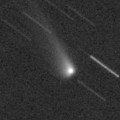
|
Now it is 17.2 mag (May 19, CAO, San Pedro de Atacama). Fading now. It stays observable in good condition for a long time after this in the Southern Hemisphere. It stays low in the Northern Hemisphere.
Date(TT) R.A. (2000) Decl. Delta r Elong. m1 Best Time(A, h)
July 14 0 56.20 -17 14.0 4.243 4.602 104 15.8 3:13 (322, 29)
July 21 0 53.11 -18 56.4 4.150 4.623 111 15.7 3:19 (332, 31)
|

|
It brightened rapidly. Now it is 15.7 mag (July 13, Toshihiko Ikemura, Hirohisa Sato). It will be fading after this, and will be fainter than 18 mag in September.
Date(TT) R.A. (2000) Decl. Delta r Elong. m1 Best Time(A, h)
July 14 14 57.65 3 25.3 1.456 2.023 108 15.8 20:57 ( 38, 52)
July 21 15 4.03 -0 22.9 1.531 2.046 105 15.9 20:52 ( 40, 47)
|

|
Now it is 15.9 mag (July 14, iTelescope Observatory, Siding Spring). It will brighten up to 12 mag in autumn in 2019. It stays observable in good condition for a while in the Southern Hemisphere. It will become observable after August also in the Northern Hemisphere. But it stays extremely low for a long time.
Date(TT) R.A. (2000) Decl. Delta r Elong. m1 Best Time(A, h)
July 14 3 9.99 -41 12.0 5.090 5.145 87 16.1 3:13 (315, -8)
July 21 3 12.01 -41 30.9 4.977 5.096 90 16.1 3:19 (320, -4)
|

|
Now it is 16.2 mag (June 17, Jean-Francois Soulier). It stays 16 mag for a while. In the Southern Hemisphere, it stays observable until August, but it will be unobservable after that. In the Northern Hemisphere, it becomes observable in good condition after this. Its cometary activity was observed on Mar. 26 (M. Mommert, D. Polishook, N. Moskovitz).
Date(TT) R.A. (2000) Decl. Delta r Elong. m1 Best Time(A, h)
July 14 2 21.68 20 23.6 1.478 1.506 71 16.3 3:13 (271, 39)
July 21 2 31.36 23 50.1 1.468 1.555 75 16.4 3:19 (271, 46)
|
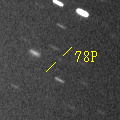
|
Now it is 17.2 mag (June 13, Toshihiko Ikemura, Hirohisa Sato). It stays at 13 mag for a long time from winter to autumn in 2019. It stays observable in good condition until winter when the comet brightens up to 13 mag.
Date(TT) R.A. (2000) Decl. Delta r Elong. m1 Best Time(A, h)
July 14 22 2.75 -2 54.5 1.987 2.833 138 17.0 2:37 ( 0, 52)
July 21 22 0.63 -2 53.1 1.902 2.801 145 16.8 2:07 ( 0, 52)
|
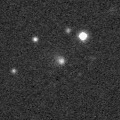
|
It brightened rapidly, and brightened up to 16.0 mag in spring (Apr. 14,Catalina Sky Survey). Now it is fading slowly. It has already faded down to 17.9 mag (July 14, Toshihiko Ikemura, Hirohisa Sato). It will be getting low after this.
Date(TT) R.A. (2000) Decl. Delta r Elong. m1 Best Time(A, h)
July 14 13 15.15 -1 33.0 1.846 2.055 86 17.0 20:57 ( 61, 32)
July 21 13 26.05 -2 28.4 1.911 2.051 82 17.0 20:52 ( 62, 30)
|

|
It brightened up to 14.8 mag in May (May 26, Ken-ichi Kadota). It stays observable in good condition for a while. But it will fade out rapidly after this. It has already faded down to 18.3 mag (July 13, Toshihiko Ikemura, Hirohisa Sato). It will be fainter than 18 mag in August.
Date(TT) R.A. (2000) Decl. Delta r Elong. m1 Best Time(A, h)
July 14 14 49.97 -11 48.9 1.620 2.215 112 17.0 20:57 ( 31, 38)
July 21 14 36.87 -10 17.5 1.816 2.259 102 17.3 20:52 ( 41, 35)
|
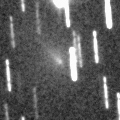
|
Now it is 17.2 mag (June 21, Kunihiro Shima). It is observable in good condition after this in the Southern Hemisphere. But it stays low in the Northern Hemisphere.
Date(TT) R.A. (2000) Decl. Delta r Elong. m1 Best Time(A, h)
July 14 19 2.64 -43 35.9 1.411 2.381 157 17.0 23:30 ( 0, 11)
July 21 18 22.41 -44 34.6 1.522 2.447 148 17.3 22:23 ( 0, 10)
|

|
Now it is 17.1 mag (June 13, Toshihiko Ikemura, Hirohisa Sato). It will be fading gradually after this, and it will be fainter than 18 mag in winter. In the Northern Hemisphere, it stays observable in good condition for a long time. In the Southern Hemisphere, it will never be observable again.
Date(TT) R.A. (2000) Decl. Delta r Elong. m1 Best Time(A, h)
July 14 23 49.09 75 32.8 7.576 7.379 75 17.1 3:13 (187, 49)
July 21 23 49.11 76 6.8 7.560 7.404 77 17.1 3:19 (183, 49)
|
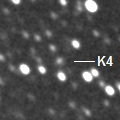
|
Now it is 17.2 mag (May 21, Toshihiko Ikemura, Hirohisa Sato). It was observed at 16 mag from summer to autumn in 2017. It will be observable at 17 mag in good condition also in 2018. It locates somewhat low in the Southern Hemisphere.
Date(TT) R.A. (2000) Decl. Delta r Elong. m1 Best Time(A, h)
July 14 1 2.01 23 51.6 3.102 3.226 87 17.1 3:13 (280, 57)
July 21 1 5.81 24 56.9 3.051 3.265 92 17.1 3:19 (285, 64)
|

|
Now it is 16.9 mag (May 15, Toshihiko Ikemura, Hirohisa Sato). It will be fainter than 18 mag in summer.
Date(TT) R.A. (2000) Decl. Delta r Elong. m1 Best Time(A, h)
July 14 14 26.78 -3 29.8 6.254 6.574 104 17.2 20:57 ( 42, 42)
July 21 14 27.25 -3 10.2 6.386 6.595 97 17.2 20:52 ( 48, 39)
|

|
Now it is 17.1 mag (July 13, Toshihiko Ikemura, Hirohisa Sato). It stays 17 mag until August. It is observable in good condition in the Northern Hemisphere. It will be getting low and becom unobservable soon in the Southern Hemisphere.
Date(TT) R.A. (2000) Decl. Delta r Elong. m1 Best Time(A, h)
July 14 2 21.91 26 0.7 1.255 1.317 69 17.2 3:13 (265, 42)
July 21 2 41.36 31 49.3 1.247 1.326 70 17.2 3:19 (259, 47)
|

|
Now it is 19.2 mag (June 13, Toshihiko Ikemura, Hirohisa Sato). It was expected to brighten rapidly up to 10 mag in autumn. But actually, it is much fainter than expected. It will be observable in excellent condition in the Northern Hemisphere. It stays low in the Southern Hemisphere.
Date(TT) R.A. (2000) Decl. Delta r Elong. m1 Best Time(A, h)
July 14 23 33.37 3 56.9 1.232 1.906 115 17.7 3:13 (335, 57)
July 21 23 41.35 5 57.9 1.131 1.856 119 17.3 3:19 (346, 60)
|
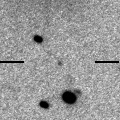
|
It is expected to brighten up to 7-8 mag in 2020. It is already observable in good condition in the Southern Hemisphere. It will become observable in good condition also in the Northern Hemisphere.
Date(TT) R.A. (2000) Decl. Delta r Elong. m1 Best Time(A, h)
July 14 3 51.20 -3 39.7 7.542 7.083 59 17.4 3:13 (280, 8)
July 21 3 53.78 -3 36.9 7.395 7.027 65 17.3 3:19 (285, 14)
|
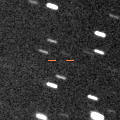
|
Now it is 18.1 mag (June 13, Toshihiko Ikemura, Hirohisa Sato). It will be observable at 16.5 mag in good condition from August to September.
Date(TT) R.A. (2000) Decl. Delta r Elong. m1 Best Time(A, h)
July 14 21 51.24 -4 52.5 1.485 2.372 142 17.6 2:26 ( 0, 50)
July 21 21 50.13 -4 36.2 1.409 2.338 148 17.3 1:57 ( 0, 50)
|

|
Now it is 18.9 mag (July 9, W. Hasubick). It will approach to Earth down to 0.08 a.u. in December, and it is expected to brighten up to 3 mag. In the Northern Hemisphere, it stays observable in excellent condition. In the Southern Hemisphere, it is observable in good condition until mid December when it brightens up to 3 mag. But it becomes unobservable after that.
Date(TT) R.A. (2000) Decl. Delta r Elong. m1 Best Time(A, h)
July 14 0 32.52 -13 14.5 1.526 2.084 108 18.0 3:13 (326, 35)
July 21 0 41.95 -13 24.1 1.404 2.026 112 17.6 3:19 (332, 37)
|
|
![]()
 364P/2018 A2 ( PanSTARRS )
364P/2018 A2 ( PanSTARRS ) C/2016 R2 ( PanSTARRS )
C/2016 R2 ( PanSTARRS ) 66P/du Toit
66P/du Toit C/2016 N6 ( PanSTARRS )
C/2016 N6 ( PanSTARRS ) 48P/Johnson
48P/Johnson 29P/Schwassmann-Wachmann 1
29P/Schwassmann-Wachmann 1 37P/Forbes
37P/Forbes C/2015 O1 ( PanSTARRS )
C/2015 O1 ( PanSTARRS ) C/2017 M4 ( ATLAS )
C/2017 M4 ( ATLAS ) 38P/Stephan-Oterma
38P/Stephan-Oterma 49P/Arend-Rigaux
49P/Arend-Rigaux C/2017 B3 ( LINEAR )
C/2017 B3 ( LINEAR ) 65P/Gunn
65P/Gunn C/2018 L2 ( ATLAS )
C/2018 L2 ( ATLAS ) C/2015 V2 ( Johnson )
C/2015 V2 ( Johnson ) (944) Hidalgo
(944) Hidalgo C/2015 V1 ( PanSTARRS )
C/2015 V1 ( PanSTARRS ) C/2018 C2 ( Lemmon )
C/2018 C2 ( Lemmon ) C/2018 N2 ( ASASSN )
C/2018 N2 ( ASASSN ) (3552) Don Quixote
(3552) Don Quixote 78P/Gehrels 2
78P/Gehrels 2 105P/Singer Brewster
105P/Singer Brewster C/2018 K1 ( Weiland )
C/2018 K1 ( Weiland ) C/2017 S6 ( Catalina )
C/2017 S6 ( Catalina ) C/2014 OE4 ( PanSTARRS )
C/2014 OE4 ( PanSTARRS ) C/2017 K4 ( ATLAS )
C/2017 K4 ( ATLAS ) C/2017 E3 ( PanSTARRS )
C/2017 E3 ( PanSTARRS ) C/2018 M1 ( Catalina )
C/2018 M1 ( Catalina ) 64P/Swift-Gehrels
64P/Swift-Gehrels C/2017 T2 ( PanSTARRS )
C/2017 T2 ( PanSTARRS ) 137P/Shoemaker-Levy 2
137P/Shoemaker-Levy 2 46P/Wirtanen
46P/Wirtanen![]()


























